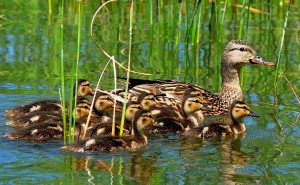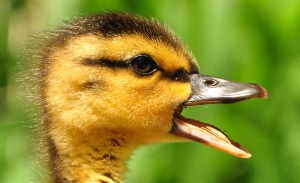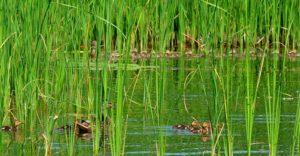Photography courtesy of Lowell Washburn, all rights reserved.
When autumn winds blow and fall weather sets in, Iowa waterfowl hunting enthusiasts can anticipate a strong duck migration during 2015. That’s the official assessment for this year’s North American Breeding Duck and Habitat Survey released this week by the U.S. Fish & Wildlife Service.
Conducted every spring since 1955, the annual survey measures trends in duck breeding populations and monitors wetland [pond] indexes across large portions of prairie and boreal Canada and the northern U.S. During this year’s survey, a total of 49.5 million breeding ducks were tallied – a count similar to last year and 43 percent above the 1955-2013 Long Term Average [LTA]. A total of 6.3 million ponds were also inventoried this spring; down 12 percent from 2014 but remaining 21percent above the LTA. The decrease in pond numbers was attributed to poor spring runoff and lack of early precipitation across parts of the northern U.S. and southern Canada.
Species Highlights: A surveyed breeding population of 11.6 million mallard ducks was reported by the Fish & Wildlife Service during 2015 – a seven percent increase from last year’s high count, and 51 percent above the LTA. A total of 8.5 million blue-winged teal were inventoried; unchanged from 2014 and 73 percent above the LTA. Green-winged teal populations rose to 4.1 million breeders; a 19 percent increase over last year and 98 percent above the long term average. A total of 760,000 breeding canvasback ducks were reported; an eleven percent increase over last spring and 30 percent above the LTA.
But not all duck species enjoyed and increase in numbers or even held their own. The number of prairie nesting redhead ducks declined by 6 percent to 1.9 million breeders during 2015 but remain 71 percent above the LTA. American wigeon, shovelers, northern pintails, and lesser scaup also suffered population declines during 2015. Pintail numbers have dropped to 24 percent below the long term average; lesser scaup are 13 percent below the average. Despite these declines, however, total duck numbers remain strong and above average for 2015.
Although anticipation is already beginning to mount as we move toward fall, Iowa hunters still have a couple of months to go until the opener of this year’s duck season. A lot can change between now and fall. As always, the success of the Iowa duck season will depend on local wetland conditions, developing fall weather patterns and, of course, upon the migratory whims of the birds themselves. Although plenty of uncertainties remain, one fact is sure. When autumn winds begin to blow, a projected fall flight easily exceeding 100 million ducks will be heading down the flyways. That’s a forecast that should stir the blood of any duck hunter.
LW
July 2015




 Susan Judkins Josten
Susan Judkins Josten Rudi Roeslein
Rudi Roeslein Elyssa McFarland
Elyssa McFarland Mark Langgin
Mark Langgin Adam Janke
Adam Janke Joe Henry
Joe Henry Sue Wilkinson
Sue Wilkinson Tom Cope
Tom Cope Kristin Ashenbrenner
Kristin Ashenbrenner Joe Wilkinson
Joe Wilkinson Dr. Tammy Mildenstein
Dr. Tammy Mildenstein Sean McMahon
Sean McMahon